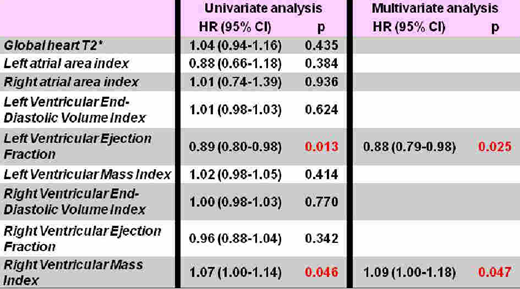Introduction: Cardiac magnetic resonance (CMR) is the non-invasive gold standard for the quantification of biventricular functional parameters and for myocardial tissue characterization.
The aim of this study was to prospectively assess the predictive value of CMR parameters for cardiovascular complications in sickle cell disease (SCD) patients.
Methods: We considered 102 white SCD patients (34.38±12.67 years, 53 females) consecutively enrolled in the Myocardial Iron Overload in Thalassemia (MIOT) network.
Myocardial iron overload (MIO) was measured by the multislice multiecho T2* technique. Atrial dimensions and biventricular function parameters were quantified by cine images.
Results: At baseline CMR only two patients had MIO (global heart T2*<20 ms).
During a mean follow-up was of 63.29±24.41 months, 10 cardiac events (9.8%) were registered: 3 pulmonary hypertension, 1 pulmonary embolism, 1 peripheral vascular disease, 1 transient ischemic attack, 2 supraventricular arrhythmias, 1 heart failure, and 1 death after acute chest syndrome.
CMR predictors of cardiovascular events at univariate analysis were left ventricular ejection fraction and right ventricular mass index (see Table). Both variables remained independent predictors at multivariate analysis (see Table).
Conclusions: Reduced left ventricular ejection fraction and increased right ventricular mass index showed a significant prognostic value in patients with SCD. Our data seem to suggest that also CMR could be added as screening tool for identifying SCD patients at high risk for pulmonary and systemic vasculopathy and death.
Pepe:Chiesi Farmaceutici S.p.A., ApoPharma Inc., and Bayer: Other: No profit support.
Author notes
Asterisk with author names denotes non-ASH members.


This feature is available to Subscribers Only
Sign In or Create an Account Close Modal